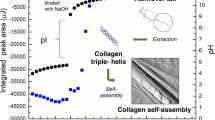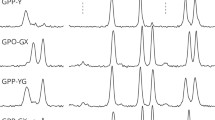Abstract
The paper investigated the conformation and stability of the chromium(III)-crosslinked collagen fibers under different moisture contents by the molecular dynamics method, focusing on making a qualitative and quantitative analysis for the H-bonds. The water-mediated hydrogen bonding and direct hydrogen bonding interaction between neighboring bundles are the main driving force of the assembly of collagen fibrils. The right amount of moisture can well trig the conformation of collagen fibrils, during which water acts as a crosslinking role through the bridging hydrogen bonds. The Gly, Glu, Arg, Asp, and Lys play major roles in the formation of the direct hydrogen bonds, in which the amino acid with a long side chain, such as Arg and Glu, is particularly likely to form intrachain hydrogen bonds. The competition and disturbance of the water molecules lead to the great loss of the direct H-bonds. Anyway, a certain amount of intrachain hydrogen bonds is able to block the active sites in collagen and keep these sites away from the other molecules.





Similar content being viewed by others
References
Shoulders MD, Raines RT (2009) Collagen structure and stability. Annu Rev Biochem 78:929–958
Przybyla DE, Chmielewski J (2010) Higher-order assembly of collagen peptides into nano- and microscale materials. Biochemistry 49(21):4411–4419
Punitha V, Raman SS, Parthasarathi R, Subramanian V, Rao JR, Nair BU, Ramasami T (2009) Molecular dynamics investigations on the effect of d amino acid substitution in a triple-helix structure and the stability of collagen. J Phys Chem B 113:8983–8992
Li Y, Asadi A, Monroe MR, Douglas EP (2009) pH effects on collagen fibrillogenesis in vitro: electrostatic interactions and phosphate binding. Mater Sci Eng C Mater 29:1643–1649
Xiao J, Baum J (2009) Structural insights from 15N relaxation data for an anisotropic collagen peptide. J Am Chem Soc 131:18194–18195
Pradhan SM, Katti KS, Katti DR (2012) Structural hierarchy controls deformation behavior of collagen. Biomacromolecules 13:2562–2569
Kramer RZ, Bella J, Mayville P, Brodsky B, Berman HM (1999) Sequence dependent conformational variations of collagen triple-helical structure. Nat Struct Biol 6:454–457
Ramachandran GN, Chandrasekharan R (1968) Interchain hydrogen bonds via bound water molecules in the collagen triple helix. Biopolymers 6:1658–1694
Monti S (2007) Molecular dynamics simulations of collagen-like peptide adsorption on titanium-based material surfaces. J Phys Chem C 111:6086–6094
Rele S, Song Y, Apkarian RP, Qu Z, Conticello VP, Chaikof EL (2007) D-periodic collagen-mimetic microfibers. J Am Chem Soc 29:14780–14787
Raman SS, Parthasarathi R, Subramanian V, Ramasami T (2006) Role of aspartic acid in collagen structure and stability: a molecular dynamics investigation. J Phys Chem B 110:20678–20685
Raman SS, Gopalakrishnan R, Wade RC, Subramanian V (2011) Structural basis for the varying propensities of different amino acids to adopt the collagen conformation. J Phys Chem B 115:2593–2607
Fu I, Case DA, Baum J (2015) Dynamic water-mediated hydrogen bonding in a collagen model peptide. Biochemistry 54:6029–6037
Ding YQ, Chen CL, Gu QR, Liao JM, PH Chuang (2014) Application of molecular simulation to investigate chrome(III)-crosslinked collagen problems. Model Simul Mater Sci 22:035007–035020
Orgel JP, Irving TC, Miller A, Wess TJ (2006) Microfibrillar structure of type I collagen in situ. Proc Natl Acad Sci USA 103:9001–9005
Kudin KN, Scuseria GE (1998) A fast multipole method for periodic systems with arbitrary unit cell geometries original research article. Chem Phys Lett 283:61–68
Kudin KN, Scuseria GE (2000) Linear-scaling density-functional theory with gaussian orbitals and periodic boundary conditions: efficient evaluation of energy and forces via the fast multipole method. Phys Rev B 61:16440–16453
Yazyev OV, Kudin KN, Scuseria GE (2002) Efficient algorithm for band connectivity resolution. Phys Rev B 65:205117–205124
Ding YQ, Chen CL, Gu QR, Fu LH (2014) Molecular simulation study of the effects of inorganic anions on the properties of chrome-crosslinked collagen. Model Simul Mater Sci Eng 22:065008–065020
Ding YQ, Chen CL, Li TD, Cheng JY, Zhang HY (2015) Effects of chromium-olation length on crosslinking effects investigated by molecular dynamics simulation. Soft Mater. 13:24–31
Phillips JC, Braun R, Wang W, Gumbart J, Tajkhorshid E, Villa E, Chipot C, Skeel RD, Kale L, Schulten K (2005) Scalable molecular dynamics with NAMD. J Comput Chem 26:1781–1802
Cook GA, Dawson LA, Tian Ye, Opella SJ (2013) Three-dimensional structure and interaction studies of hepatitis C virus p7 in 1,2-dihexanoyl-sn-glycero-3-phosphocholine by solution nuclear magnetic resonance. Biochemistry 52(31):5295–5303
Lopes PEM, Huang J, Shim J, Luo Y, Li H, Roux B, MacKerell AD Jr (2013) Polarizable force field for peptides and proteins based on the classical drude oscillator. J Chem Theory Comput 9(12):5430–5449
Brooks BR, Bruccoleri RE, Olafson BD, States DJ, Swaminathan S, Karplus M (1983) CHARMM: a program for macromolecular energy, minimization, and dynamics calculations. J Comput Chem 4(2):187–217
MacKerell AD Jr, Brooks B, Brooks CL III, Nilsson L, Roux B, Won Y, Karplus M (1998) The encyclopedia of computational chemistry, vol 1. Wiley, Chichester, p 271
MacKerell AD Jr et al (1998) All-atom empirical potential for molecular modeling and dynamics studies of proteins. J Phys Chem B 102(18):3586–3616
Li YW, Sun XM, Du LK, Zhang QZh, Wang WX (2012) QM/MM study on the spontaneous reactivation mechanism of (±) methamidophos-inhibited-acetylcholinesterase. Comput Theor Chem 980:108–114
Acknowledgments
This work was financially by the Project of Natural Science Foundation of Shandong Province (ZR2014EMM020), the National Natural Science Foundation of China (Nos. 21376125 and 21477065), and the Foundation of Development and Application of Urban Clean Air Planning and Management Tool (G-1210-17094). This work was technically supported by the Open Project Program for Scientific Research Innovation Team in Colleges and Universities of Shandong Province. This software NAMD was provided by the Theoretical and Computational Biophysics group, NIH Center for Macromolecular Modeling and Bioinformatics, at the Beckman Institute, University of Illinois at Urbana-Champaign.
Author information
Authors and Affiliations
Corresponding author
Rights and permissions
About this article
Cite this article
Ding, Yq., Guo, Dh., Cheng, Jy. et al. A description of hydrogen bonds in the chromium(III)-crosslinked collagen: insight from the molecular dynamics simulation. Struct Chem 27, 1255–1263 (2016). https://doi.org/10.1007/s11224-016-0752-7
Received:
Accepted:
Published:
Issue Date:
DOI: https://doi.org/10.1007/s11224-016-0752-7




